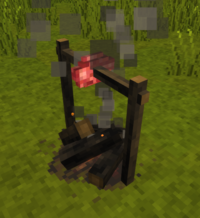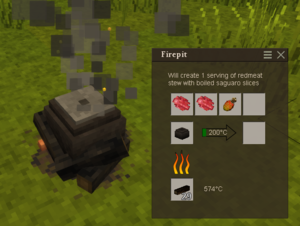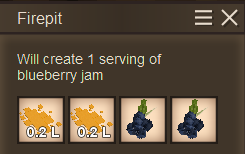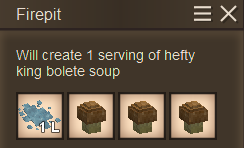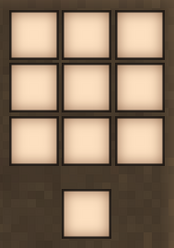Cooking/en-gb: Difference between revisions
(Updating to match new version of source page) |
(Updating to match new version of source page) |
||
| Line 27: | Line 27: | ||
| <span lang="en" dir="ltr" class="mw-content-ltr">Saguaro fruit</span> || 60 || <span lang="en" dir="ltr" class="mw-content-ltr">Fruit</span> || <span lang="en" dir="ltr" class="mw-content-ltr">Restores 1 hp upon consumption.</span> | | <span lang="en" dir="ltr" class="mw-content-ltr">Saguaro fruit</span> || 60 || <span lang="en" dir="ltr" class="mw-content-ltr">Fruit</span> || <span lang="en" dir="ltr" class="mw-content-ltr">Restores 1 hp upon consumption.</span> | ||
|- | |- | ||
| <span lang="en" dir="ltr" class="mw-content-ltr">Apple, blueberry, red currant, white currant, black currant,<br> mango, orange, peach, pear, pomegranate, or pineapple slice</span> || 80 || <span lang="en" dir="ltr" class="mw-content-ltr">Fruit</span> || | | <span lang="en" dir="ltr" class="mw-content-ltr">Apple, blueberry, red currant, white currant, black currant,<br>mango, orange, peach, pear, pomegranate, or pineapple slice</span> || 80 || <span lang="en" dir="ltr" class="mw-content-ltr">Fruit</span> || | ||
|- | |- | ||
| <span lang="en" dir="ltr" class="mw-content-ltr">Breadfruit</span> || 200 || <span lang="en" dir="ltr" class="mw-content-ltr">Fruit</span> || | | <span lang="en" dir="ltr" class="mw-content-ltr">Breadfruit</span> || 200 || <span lang="en" dir="ltr" class="mw-content-ltr">Fruit</span> || | ||
Revision as of 15:28, 11 December 2023
Raw edibles
At the start of the game, without any infrastructure, the player only has access to foraged or hunted food that can be eaten raw in order to maintain the player's satiety. However, the player should not rely on these for overly long, as once harvested, naturally occurring foodstuffs are either gone for good, or require a long time to regrow.
The following table lists all the food items that can be eaten raw:
| Item | Satiety | Category | Notes |
|---|---|---|---|
| Honey1 (per 0.1 liter) | 30 | Fruit | Liquid. Never spoils. |
| Cherry, lychee | 40 | Fruit | |
| Cranberry | 60 | Fruit | |
| Saguaro fruit | 60 | Fruit | Restores 1 hp upon consumption. |
| Apple, blueberry, red currant, white currant, black currant, mango, orange, peach, pear, pomegranate, or pineapple slice |
80 | Fruit | |
| Breadfruit | 200 | Fruit | |
| Mushroom | 80 | Vegetable | Some mushroom types may be poisonous and deal damage upon consumption. |
| Bell pepper2, carrot, olive, onion, parsnip, or turnip | 100 | Vegetable | |
| Cassava (processed) | 100 | Vegetable | Inedible without prior processing. |
| Cabbage | 300 | Vegetable | |
| Pumpkin slice | 140 | Vegetable | |
| Pumpkin (whole) | 480 | Vegetable | Since version 1.19, it is no longer possible to eat a whole pumpkin. |
| Flax grain | 30 | Grain | |
| Amaranth, rice, rye, spelt, or sunflower grain | 60 | Grain | |
| Walnut seed | 40 | Protein | Never spoils. |
| Termite | 60 | Protein | |
| Peanut | 160 | Protein | |
| Lump of fat3 | 200 | Protein | Never spoils. |
| Vintage Beef | 280 | Protein | Rare ruin loot. Restores 2 hp upon consumption. Never spoils. |
| Milk (per 0.1 liter) | 15 | Dairy | Liquid. |
| Fish | 220 | Protein |
1 Consuming honey used to restore health in older versions. It no longer does as of version 1.16.
2 Bell peppers are unobtainable in survival gameplay as of version 1.16.
3 Lumps of fat are a valuable crafting material that should be eaten only in emergencies.
Mushrooms
Mushrooms are special in that they may be beneficial or harmful to the player when ingested, and some of the harmful ones are very easily mistaken for safe ones.
Following is a list of specifically poisonous mushrooms for easy checking:
| Name | Notes |
|---|---|
| Bitter bolete | -3 hp |
| Death cap | -50 hp (!) |
| Devilstooth mushroom | -2 hp |
| Earth ball | -8 hp |
| Elfin saddle | -7 hp |
| Fly agaric | -6.5 hp |
| Funeral bell | -40 hp (!) |
| Gold-drop milkcap | -2.5 hp |
| Jack'o'lantern mushroom | -6 hp |
| Pink bonnet | -10 hp |
The first opportunity for making better food comes with the firepit. A small number of foraged or hunted ingredients can be placed directly into it for processing. Additionally, it can be used for baking dough into bread in a pinch, but the result will be of lesser quality than when using an oven.
Current nutrition and satiety levels can be examined in the character dialog, mapped to 'C' by default.
| Item | Satiety | Category | Notes |
|---|---|---|---|
| Cooked cattail or papyrus root | 100 | Vegetable | |
| Cooked bushmeat | 120 | Protein | |
| Cooked poultry | 200 | Protein | |
| Cooked redmeat | 280 | Protein | |
| Cooked fish | 200 | Protein | |
| Charred flax bread | 100 | Grain | Requires prior processing. |
| Charred amaranth, cassava, rye, spelt, or sunflower bread | 210 | Grain | Requires prior processing. |
| Charred rice bread | 220 | Grain | Requires prior processing. |
Bread Dough
To create bread dough, prepare flour using a quern to grind grain.
- Open the quern GUI (RMB) and add grain into the input slot (left) of the quern.
- Hold RMB on the base of the quern to grind the grain into flour, which will appear in the output slot (right) of the quern.
- In the crafting grid, combine a bucket of water and flour to create dough. (one bucket of water creates 10 dough)
Advanced cooking techniques can greatly increase the food value of ingredients, and can potentially achieve several thousands of satiety points in a single food item. Additionally, it allows the player to make meals out of multiple ingredients, which can potentially supply multiple nutrition groups at he same time. Whenever possible, it is recommended that the player uses advanced cooking techniques.
Cooking meals
- See also: Meal
Baking
Place the dough into the input slot of the firepit and fuel the fire. (Each loaf of bread requires about one piece of firewood.) Both dough and bread loaves stack to 32.
Advanced Cooking
To prepare more wholesome meals, craft a claypot using the clay forming mechanic. Place the burned claypot into the fire pit input slot (left) to cook any of the 5 available meal types. The meal type players create is determined by which two "required" ingredients are placed into the claypot.
- To create one serving of any meal: place one of each required item into two separate claypot slots (this defines the meal type). For example, a porridge requires "two grain", so a player must add two individual pieces of grain in any two input slots in the claypot. Placing two grain in one input slot of the claypot will not create a porridge. Adding "optional" ingredients in the other two input slots of the claypot will increase the nutrition value and satiation of the meal depending on which items are added. When a valid meal recipe (combining correct ingredients) is placed into the input slots, a message will appear in the claypot dialog box informing players about what type of meal will be created after cooking.
| Advanced recipes | Meat stew | Vegetable stew | Porridge | Soup | Jam | Scrambled eggs |
|---|---|---|---|---|---|---|
| Required ingredients | 2 poultry or red meat or raw fish (cured or fresh) | 2 vegetables or soybeans | 2 grain | 1 vegetable (fresh) + 1L water1 | 2 fruit + 2x 0.2L honey1 | 2 egg |
| Optional protein | 0 - 2 protein | 0 - 2 soybean | 0 - 1 poultry or red meat or raw fish (cured or fresh), or egg | |||
| Optional vegetable | 0 - 2 vegetable | 0 - 2 vegetable | 0 - 2 vegetable | 0 - 2 vegetable | 0 - 2 vegetable | |
| Optional grain | 0 - 2 grain | |||||
| Optional fruit | 0 - 1 fruit, 0L - 0.2L honey1 | 0 - 2 fruit, 0L - 0.2L honey1 | ||||
| Optional dairy | 0 - 2 cheese |
1 Liquids can be added to the pot with a bucket (1L portions), jug (0.3L portions), or bowl (0.1L portions). Pick up the liquid container with your cursor and drag it over an empty spot in the cooking pot. Use ![]() to add one portion,
to add one portion, ![]() to remove one portion.
to remove one portion.
- To store meals: Four portions of any cooked meal can be stored in an empty crock. Place the pot onto the ground or table and right click the pot with an empty crock to transfer meals to the storage crock. Storage crocks may be sealed for long term storage using fat or wax in the crafting grid, Crocks may also be carried in player inventories, stored in stationary containers, and placed on shelves.
The satiety received from eating meals is equal to the sum of its ingredients. The ingredients added to create the meal determine how much satiety of each class of nutrition the player receives. In addition, the food values of most ingredients are increased via cooking, as shown in the table below.
Pickled variants of listed ingredients can be used, but provide only their tooltip-listed food value, without gaining any bonus from meals.
Ingredients not listed in this table cannot be used in cooking pot meals.
Advanced Cooking Recipes
| Protein | Satiety in a meal | Vegetable | Satiety in a meal | Grain | Satiety in a meal | Fruit | Satiety in a meal | Dairy | Satiety in a meal |
|---|---|---|---|---|---|---|---|---|---|
| Soybean | 240 | Field vegetable1 or olive | 150 | Flax grain | 120 | Blueberry, red currant, white currant or black currant | 120 | Blue cheese (slice) | 200 |
| Egg | 200 | Cassava | 120 | Rice grain | 280 | Tree fruits2 or pineapple slice | 120 | Cheddar (slice) | 240 |
| Poultry, cured or fresh | 375 | Pumpkin slice | 180 | Rye or spelt grain | 240 | Cranberries or saguaro fruit3 | 90 | ||
| Redmeat, cured or fresh | 420 | Cabbage | 450 | Amaranth or cassava grain | 240 | Honey (0.2L) | 80 | ||
| Mushroom3 | 120 | Sunflower grain | 240 | Breadfruit | 250 | ||||
| Cherry or lychee | 60 |
1 Field vegetables include carrots, parsnips, onions, turnips, and bell peppers.
2 Tree fruits include apples, mangoes, oranges, peaches, pears, and pomegranates.
3 Ingredients that restore player health when eaten raw, such as saguaro fruit, lose this benefit when cooked. However, cooking a poisonous mushroom does not remove its harmful effects - the meal will still damage the player!
Satiation
Player satiety is how "hungry" or "well-fed" a player is, and has a maximum value of 1500. The satiation received from eating simple foods is shown in the table below. The satiation received from eating meals is "equal to the sum of its parts". The ingredients added to create the meal determine how much satiation and which class of nutrition a player receives. In addition, for every 100 satiation filled by consuming a meal, an additional 30 seconds passes before the player's satiety bar starts dropping again.
Baking is an advanced cooking method that revolves around dough, the creation of which requires some setup. A quern must be available, which requires metal tools to craft. Additionally, a clay oven should be set up for baking, as not all recipes can be baked in the firepit, and the results there are always subpar. Plus, a wooden bucket, a jug or a bowl is needed to be filled with water. Finally, a farm is required to consistently supply useful amounts of grain, as wild crops are nonrenewable, mature extremely slowly, and reset their growth after reaching maturity.
- Saguaro and Honey provide health points to the player when consumed.
Basic Cooking
Simple cooking includes placing raw meat, bread dough, or cattail roots in the firepit. Roasting makes these 3 types of raw food edible. All other ingredients require a clay pot to be cooked.
- Open the quern GUI and add grain into the input slot on the left of the quern.
- Hold
interact on the top of the quern to grind the grain into flour, which will appear in the output slot on the right of the quern.
During later stages of the game, a windmill may be used to drive the quern. - In the crafting grid, combine a bucket of water and flour to create dough. Each flour item will consume one unit of water from the bucket (1L).
Two foods can be baked at the moment: bread and pie. Both of them represent a significant advantage over consuming grain as porridge, and fully-filled pies can grant enormous nutrition with long spoilage times. Each serving of pie also halts the hunger meter for 30 seconds, greatly helping players with high hunger rates due to equipping heavy armor or offhand items.
- Add water or honey with a filled bucket. Use LMB to add one portion, RMB to remove one portion.
Check the food preservation page to learn how to best store all those delicious meals!
Advanced Cooking Food Values
Meals have a 50% extra satiety bonus from the ingredients' total satiety.
| Protein | Satiation in Meal | Vegetable | Satiation in Meal | Grain | Satiation in Meal | Fruit | Satiation in Meal |
|---|---|---|---|---|---|---|---|
| Soy Bean | 240 | Roots: Carrot, Parsnip, Onion, Turnip | 150 | Flax | 120 | Currants, Blueberry | 120 |
| Egg | 200 | Cabbage | 450 | Rice | 240 | Cranberry | 90 |
| Poultry | 375 | Pumpkin | 180 | Rye | 240 | Saguarro | 90 |
| Red Meat | 420 | Mushrooms (Bolete, Field) | 120 | Spelt | 240 | Honey | 80 |
| Claypot Cooking (no real changes since version 1.12) |
|---|
| Food and Cooking | |
|---|---|
| Finding food | Foraging • Farming • Animal husbandry • Cooking |
| Edibles | Fruit • Vegetable • Meat • Grain • Mushroom • Honey • Cheese |
| Meals | Vegetable stew • Meat stew • Soup • Porridge • Scambled eggs • Bread • Pie |
| Food preservation | Pickles • Cured meat • Jam • Cheese • Alcohol • Cellar |
| Cooking tools | Firepit • Clay oven • Cooking pot • Quern |
| Utensils | Bowl • Crock • Storage vessel |
| Other links | Room • Satiety |
| Wiki Navigation | |
|---|---|
| Vintage Story | Guides • Frequently Asked Questions • Soundtrack • Versions • Controls |
| Game systems | Crafting • Knapping • Clay forming • Smithing • Cooking • Temperature • Hunger • Mining • Temporal stability • Mechanical power • Trading • Farming • Animal husbandry |
| World | World generation • Biomes • Weather • Temporal storms |
| Items | Tools • Weapons • Armor • Clothing • Bags • Materials • Food |
| Blocks | Terrain • Plants • Decorative • Lighting • Functional • Ore |
| Entities | Hostile entities • Animals • NPCs • Players |
| Miscellaneous | List of client commands • List of server commands • Creative Starter Guide • Bot System • WorldEdit • Cinematic Camera • Adjustable FPS Video Recording • ServerBlockTicking |
